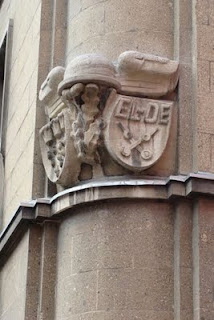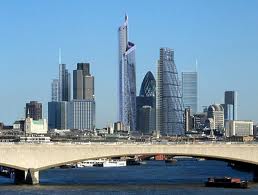Es tut mir leid!
It is my last half day - I shall have to get back to London to catch my flight to SFO tomorrow morning. I have a couple of things to do before I go, however. I grab breakfast at Hotel Domstern, and then go out to take a couple of exterior shots at the Dom. My real intent is to find my way over to Antoninkirche so that I can see the Barlach Engel. On the way, I stop at Kolumba, one last time for a couple of photographs, and a moment in the chapel, and then make my way over to the other church. As I approach it, I get a very bad feeling. It is Evangelisch, and likely to be locked.
 |
| Pentecost Door at Antonio |
I am right. The doors are locked tighter than a drum - I try each one but to no avail. I read every bulletin and announcement, and it looks like Sundays only. In the courtyard a gentleman is closing the door. I ask him when the Church is open, "Nur am Samstag" is the reply. I tell him that I had hoped to see the angel (hoping he would let me in for just a couple of minutes. "Nein, es tut mir leid" (No, I'm sorry) "Schade" (Too bad), I reply, and he says "Bitteschön!" (You're welcome!).
Every Lutheran Church that I have seen in Köln has been closed, and uninviting. Every Catholic Church has been open and quite welcoming. I should talk, my own church is closed, except for mid-day Mass during the week. This will make me think a bit. It appears that the Evangelical Church has a huge restaurant - information center that surrounds the church on two sides. Coffee? Yes! Art and Prayer? No? I am disappointed. So I wander away, hoping that something else will come up.
 |
| Pyx at Apostelnkloister |
And indeed it does, as I wander away from the closed church, I see a familiar profile up ahead. It is Apostelnkloister, a Romanesque Church of great beauty. It is open, and once inside, a gentleman comes up to me and allows me to wander and take photos. There is a remarkable hanging pyx above the altar. I have read and seen photos of such things, and always wanted to see one in use. A pyx is a vessel for holding the consecrated host (the box being held in the claws of the dove). It is quite beautiful, along with the other furnishings. Heavily bombed in the IInd World War, it is heavily rebuilt with new windows, some doors, and vault and ceiling frescoes. God has given me something else other than the Engel, and I am grateful.
 |
| Mariahimmelfahrt |
I've been walking too much, so I find a place for a macchiato and two thumbprint cookies, made with marzipan, however. I sit and relax and watch the world walk by. There are (and have been) lots of men walking their dogs - eye candy. I wander around looking for a Süßwarenladen where I might find some marzipan fruits for Mom. None are to be found. I am going to have to rely on the store at the Hbf, or at the Flughafen. I am on a mission, however. I want to go back to Egino Weinhert's studio and store next to the Erzbischofsvikariat, near the train station. He is the artist that is responsible for a great deal of the metal work that I have been seeing. In the studio it is all lying around, like so much hardware - but such beautiful hardware. Yesterday I saw an aspergillum that was afordable and a good example of the metal work of which I have been bragging in these posts. Now it is mine, my souvenir of a wonderful trip to Köln.
I go back to the hotel and prepare to check out. It is an ugly day in Köln, with thunder and lightening. I really enjoyed the Hotel Domstern - the hosts are really quite nice. I lug my stuff to the Hbf, buy a ticket (getting here it was €8,60, and the return was only €2,50). I get there quickly and with no hassles - why can't we do this in America? There lunch and then waiting for Passport Control to get there, and finally we board. Once again the Channel is covered over by clouds, but as we approach the mouth of the Thames, it clears off. We streak over Eton and Windsor, and I crash at a Holiday Inn. It was just a few days - but it was utterly refreshing.



















































